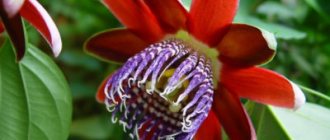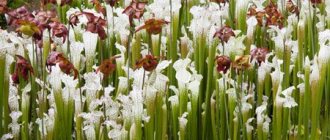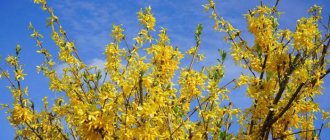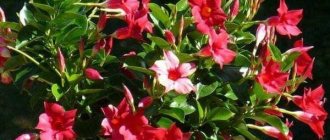Horny goat weed is a herbaceous perennial from the Barberry family. It is also known as epimedium or elf flower. The plant lives in the foothills and forest clearings of the Caucasus, Turkey, the Alps and East Asia. The ground cover with beautiful foliage is quite popular in Western Europe, but in Russian gardens it is still a rare guest. Being not only a garden decoration, but also an effective medicinal plant, Horny Goat weed deserves a place of honor in the flower garden. Moreover, it is not at all difficult to master caring for it.
Description of the plant
Horny weed grows in a very dense bush, the height of which ranges from 15 to 75 cm. Numerous shoots emerge from a strong branched rhizome.
They are quite thin, but still covered with a delicate red bark with a brown tint. Along the entire length of the shoot, taking into account its branches, there are bright green leaves on long petioles. Bushes can overwinter with them (evergreen varieties) or shed their foliage for the winter (deciduous varieties). Depending on the plant variety, the leaf blade has a different shape:
- heart-shaped;
- elongated;
- feathery;
- with serrated edge;
- with red veins.
The maximum distance between each leaf in a bush is no more than 7 cm (for some varieties it is only 1 cm), which creates a dense grassy carpet.
It is noteworthy that the mountain weed bushes develop very quickly, growing to the sides and occupying an increasingly larger territory, but at the same time the middle of the clump gradually fades.
Horny goat weed blooms in May, raising long peduncles with loose inflorescences in the form of brushes above the foliage. Each raceme consists of about a dozen medium-sized flowers. They have a very original shape: the petals are arranged in two rows, 4 on the outside, and the same number on the inside of the flower. Some varieties are distinguished by the presence of peculiar hook-spurs on the petals. After flowering ends, the seeds ripen, but there are varieties that do not bear fruit. The seeds attract ants, which carry them far beyond the boundaries of the mountain weed plantings.
There are more than fifty species of perennials, differing in the shape and color of the leaves, as well as the structure and color of the inflorescences. Some of the most famous are mountain goat weeds:
- grandiflora;
- Colchian;
- multi-colored;
- red;
- arrow-leaved;
- Korean.
Recipes for infusions of horny weed
1) Infusion for menstrual irregularities,
dissolve 1/3 teaspoon (2 g) in 600 ml of hot water. Take for adults 200 ml 3 times a day with meals.
Latin name:
Epimedium koreanum Nakai.
Chinese name:
Chaoxian yinyanghuo (Chaoxian yinyanghuo).
Family:
barberry.
Form:
herbaceous perennial plant.
Botanical description
Korean Horny Goat Weed has a thin rhizome that is located horizontally in the soil. The stems of the plant reach a height of 40 cm. There are no leaves near the root part, but sometimes there are specimens with a pair of leaves of the same length. With this development, flower stalks are located here. The leaves on the stems are solitary, attached with long petioles. Their shape resembles a heart, the structure is leathery, and the bottom plate is covered with hairs. In adulthood, the pubescence disappears and the surface becomes smooth. Hairs remain only on the petioles in small quantities. In April–May, a short flowering raceme is formed, sometimes slightly branched. The bracts are egg-shaped, the flowers reach a diameter of 20 mm. Sepals are lanceolate, pointed, white or pinkish. The petals are most often dark lilac, but sometimes white. The spur is much longer than the sepals, pointed, light yellow in color. The fruits ripen in June or July and are oval-elongated capsules with an elongated column. Each contains from 6 to 8 seeds.
Growth
Korean mountain weed is very rare in Russia and only in the Primorsky Territory. Therefore, it is included in the Red Book and is protected by the state. The plant also grows in Korea, Northeast China, and Japan. Dense forests, mainly mixed or oak, are well suited for mountain weed. Cultivating the plant is very difficult. At the moment, this is happening only at the Mountain Taiga Station of the Russian Academy of Sciences near the city of Ussuriysk. Horny goat weed is cultivated as a medicinal and ornamental species in some Asian countries.
Chemical composition and biological activity
For medicinal purposes, you can use dried or roasted Korean Horny Goat Weed herb. It contains the maximum of valuable substances: flavonoids, glycosides, alkaloids and saponins. The rhizome contains steroids and aliphatic hydrocarbons. According to the standards adopted in China, the amount of icarisides (C33H40O15) in terms of dry matter should be from 0.5%. The herb is used as an aphrodisiac, which has estrogenic and gonadotropic effects. It is also used as a tonic, promotes contraction of the smooth muscles of the uterus and has a diuretic effect. It is believed that Korean horny weed extract activates the yang energy of the kidneys, has a beneficial effect on the body's condition during rheumatism, and strengthens cartilage and bones.
Application
In Korea and China, preparations from horny weed are used to increase potency, for insomnia, psychasthenia, anemia and heart failure. They are given to women in labor to facilitate and speed up the process of childbirth instead of drug stimulation. The herb is also used for impotence, wet dreams, joint pain with numbness and muscle contraction, and during menopause. To date, no data on contraindications for the use of Korean horny weed have been identified.
Gorgeous bloom of Horny goat weed grandiflora
The evergreen plant came to us from the mountain forests of Japan and is a bush of medium size (for the species) with a height of no more than 30 cm. The leaves have a heart shape and a dense structure; a fancy bronze pattern is clearly visible on the leaf plate. The flower brush consists of one and a half dozen lilac flowers. Due to their very large size, the flower is called large-cupped mountain weed or grandiflora.
Horny goat weed inflorescences of this variety contain beneficial substances that affect men's health. On their basis, special preparations are prepared, due to which the plant is called “green Viagra”.
Many hybrid varieties have been bred based on Horny goat weed, among them it is worth highlighting:
- Red Beauty with cherry blossoms;
- Lilafi with delicate lilac flowers;
- White queen with large pure white flowers;
- Rose Queen with soft pink inflorescences;
- Purple Pixie (Purple Elf) with lilac-violet inflorescences from which white spurs are visible.
Types of mountain weed with photos
The Goryanka genus includes approximately 50 species, with several ornamental varieties also found.
Horny goat weed (grandiflorum) (Epimedium grandiflorum)
Thanks to the successful work of breeders, a large number of varieties and hybrids have been created based on this species. The evergreen clump of the plant can reach a height of 0.2 to 0.3 m. On the surface of the dense heart-shaped leaf plates there is an intricate pattern of a bronze-green hue. Racemose inflorescences consist of 4–15 lilac flowers. These flowers are known to have healing properties that are used in medicine. They are used to support men's health, which is why they are often called “green Viagra”. The best varieties:
- Lilacinum - spectacular inflorescences include flowers of a lilac-white hue;
- White Queen - the flowers of this plant are quite large and have a snow-white color;
- Pink Queen - flowers consist of deep pink petals.
Red Horny Goat Weed (Epimedium rubrum)
The bush includes a large number of upright growing shoots, which can reach a height of about 0.4 m. Small inflorescences grow on the tops of weakly leafy stems. The flowers, reaching about 15 mm in diameter, include yellowish-red petals, and in the middle they have a thickened column.
Horny goat weed (Epimedium sagittatum)
This species was discovered not so long ago. The height of the emerging clump can reach from 0.25 to 0.3 m. The lush crown includes a large number of pointed, elongated leaf plates. At the tops of the stems, few-flowered racemose inflorescences open, which consist of small flowers.
Korean or Chinese Horny Goat Weed (Epimedium koreanum)
This deciduous perennial plant reaches a height of about 15 centimeters. It is covered with rich green, monochromatic foliage. In spring, large white-purple flowers open above the bush. This species is frost-resistant and shade-tolerant. But this flower is characterized by slow growth.
Forest orchid Horny goat weed
The most widespread “plantings” of Colchis mountain weed (the second name of the species is pinnate) are found in the forests of Transcaucasia. It grows as loose evergreen bushes and reproduces by creeping rhizomes. The leaves are a beautiful dark color, the inflorescences are in the form of a simple brush with a dozen, maximum one and a half, yellow flowers, slightly reminiscent of an orchid bloom.
The variety prefers shady places, is absolutely not demanding on soil, winters well, but does not tolerate high levels of humidity.
Contraindications to the use of horny weed
The plant contains active biological components that are contraindicated in the following cases:
- Childhood.
- Individual intolerance.
- The likelihood of developing allergic reactions.
- Thyroid gland dysfunction.
Before you start taking horny weed in the form of traditional recipes or finished medications, you should consult with your doctor to prevent the development of undesirable effects. It is especially important to do this if drug treatment for impotence is prescribed.
Increasing the therapeutic dosage may cause side effects such as:
- Nausea, vomiting.
- Digestive disorders.
- Dry mouth.
If such symptoms appear, taking horny weed should be stopped until they are completely eliminated. If negative phenomena reappear, you should consult a doctor for medical assistance.
Popular hybrid Horny goat weed
Among herbaceous plants for open ground, Horny Goat Weed attracts attention with its beautiful, fairly large, yellow flowers and high drought resistance. Dense bushes grow up to 40 cm in height and are covered with red-green leaves. Abundant flowering occurs in the second decade of May and lasts for almost a month, but fruiting does not occur. The species reproduces by dividing the rhizome in spring or late summer. In winter, the flower leaves with its leaves.
Variegated Horny Goat Weed is a garden hybrid variety. Its parents are the large-flowered and Colchis varieties.
The species has several of its own hybrids, the most beautiful of them:
- Cupreum with copper-red flowers and reddish foliage;
- Sulfureum with yellow-white inflorescences and a red pattern on old leaves.
Horny goat weed - the best choice for a carpet flower bed
One of the types of evergreen perennial, more often found under the name Perralderi mountain weed. The plant's homeland is the mountain forests of Algeria, where cedars and oaks grow. It is characterized by a very dense crown, which is formed by beautiful dark green elongated leaves with sharp tips. The leaf plate at the petiole is collected and slightly convex, and in places where it begins to narrow, several denticles protrude. Bushes up to 30 cm high grow quickly and form a dense carpet, the annual growth is at least 15 cm.
Only adult leaves have a dark green color, while young ones have a beautiful bronze tint.
Horny goat weed blooms in May in loose clusters; the flowers are yellow with a barely noticeable reddish border.
How does Horny Goat Weed reproduce?
There are two ways to grow horny weed at home:
- By sowing the seeds. Despite the fact that the seedlings grow quickly, the seeds of Horny Goat Weed are a little slow to germinate. To speed up this process, they must be stratified twice by placing them in the refrigerator for a month, and then keeping them for about the same period of time at room temperature. Sow the prepared seeds at the end of March in a greenhouse with loose soil (mix peat with sand). Grown seedlings can be planted in open ground no earlier than the end of May.
- Having planted a section of an adult bush. Large specimens of Horny Weed are dug up in September and cut into several fragments. Each division should have 2-3 living buds. Plant them in a permanent place, deepening them 5 cm into the soil, and mulch them with fallen leaves on top.
Horny goat weed grown from seeds will bloom only in the third year, and cuttings can produce flower stalks already in the current season. It should also be borne in mind that some varieties reproduce only by dividing the rhizome.
When planting seedlings or cuttings, it is necessary to leave a distance of at least 30 cm between each plant, and even more for species that are distinguished by active growth and branching. Horny goat weed prefers light and nutritious soil that contains a sufficient amount of lime.
Lighting for mountain weed does not play a decisive role - it develops equally well in the sun and in the shady part of the site.
Planting and propagation
In order to plant epimedium, you need to prepare the soil and planting site. For low varieties, choose places under trees, and plant tall ones along paths or on the lawn. The soil should be loose and fertile with zero acidity. If the soil in your area is highly acidic, neutralize it with dolomite flour. In order for the soil to better allow moisture and air to pass through, you need to dig it thoroughly before planting. You can add clay and sand. Don't forget to fertilize the plant with compost.
The holes should be placed at a distance of 30-40 cm from each other. Each seedling should be buried no more than 5 cm. After planting, the plant must be covered. It is best to plant epimedium in late summer or early autumn. For breeding, it is recommended to choose frost-resistant varieties, such as grandiflora, red and multi-colored goat weed. Epimedium can grow in one place for up to 10 years. After this he needs a transplant.
Reproduction
Propagation of the Horny Goat weed flower occurs by seed or by dividing the bush. It is worth remembering that propagation by seeds is used much less frequently and takes longer, since the plant blooms only 3-4 years after planting.
In the fall, after the inflorescences have faded, you need to collect the seeds. Be careful not to overdry them, otherwise they will not sprout.
Over the next three weeks, keep the seeds at a temperature of +15...+20°C. Then place them in a damp container, maintaining the temperature at 0...+4°C. The vegetable shelf in the refrigerator is suitable for this. Then transplant into prepared containers. Don't forget to water the seedlings regularly.
To propagate epimedium by dividing the bush, you need to use sections of rhizomes. Most often this is done in late summer - early autumn. Just at this time, the roots of the plant are actively growing. Using a sharp shovel, carefully separate the required amount of roots. There is no need to dig up the entire plant - the root system is located quite close to the surface. Each seedling must be mulched immediately.
Epimedium is not only an ornamental, but also a very useful plant. Every year scientists find more and more new species. Caring for it does not require any special skills; even novice gardeners can decorate their garden with these flowers.
Easy perennial care
Horny goat weed, like most herbs, grows well without the participation of a grower. But to make the flowering more abundant and the bushes more luxuriant, a little help will not hurt. The main work is weeding the flower bed so that the weeds do not choke the plantings. You also need to water the bushes, especially in hot, dry summers, but it’s better not to overdo it: if the roots are constantly in wet soil, they begin to rot.
On fertile soil, the crop does not need additional fertilizing. If the soil is poor, you can apply compost and complex mineral fertilizer, but not more than twice a season.
Although Horny Goat Weed is a perennial plant adapted for wintering in open ground, it is better to cover it for the winter, especially evergreen varieties. In spring, it is important to remove the cover in time so that the tender young leaves do not burn under such a “blanket”.
As for diseases, horny weed has good immunity to most infections and rarely suffers from them. But pests, such as field mice or slugs, love to feast on its succulent shoots. To protect the plant from them, you can install repellers or traps.
Medicinal properties of Horny Weed, planting the plant in open ground, rules of cultivation and care
Horny goat weed, or epimedium, is a perennial crop from the barberry family. The plant can be found in most Western European countries, as well as in Asia. The Dutch and Germans call this plant “elf flower.” In our country, this plant has gained wide popularity among flower growers. It is very often found as a decorative decoration for terraces and flower beds.
Plant characteristics
Horny goat weed is a culture that is often used in medicine in many countries , for example, in Japan, China, and Korea. This perennial crop belongs to the barberry family.
Chinese traditional medicine has continued to be popular for many years. According to Chinese medicine, the horny weed plant and its medicinal properties have a positive effect on men.
The positive effect of this herb in maintaining the health of men is confirmed by the population of China. But before use, it is important to find out all the healing properties of Horny Goat Weed.
The most popular varieties
Horny weed is also called the “elf flower”; its habitat is considered to be the mountainous regions of Asia and Europe, as well as moist forests in North Africa. There are as many as 50 species of this plant. The root system of Horny Goat Weed is highly branched. The plant forms small bushes with a large number of leaves in the shape of a heart or tip.
The grass is also commonly called “lustful goat grass . This strange name arose for the plant after people saw the unusual reaction of mountain goats after eating such a plant. After this herb, the animals became more active and prone to sexual attraction.
Such a plant can be either evergreen or grow new foliage every year. Professional Chinese gardeners were able to develop a new species of mountain weed - semi-winter green. The flowers are small in size, but at the same time they have an unusual and attractive appearance. There are also a large number of colors: white, yellow, red, purple, or even a combination of several colors.
The fruits on the plant are quite dry and contain a large amount of vitamins and nutrients. That is why such a plant is preferred by ants, who carry the grains of the goat weed. After spreading by ants, such seeds begin to actively germinate, which is how the flowers reproduce.
Currently, gardeners grow about ten species of this plant in their garden plots, and although it is quite rare on estates, in the future experts believe that such a plant will spread en masse throughout Russia. There are particularly popular types of horny weed:
- Alpine mountain weed - it can be found in France, Switzerland, Germany, and Austria. The perennial flower is yellow and reaches a height of up to twenty centimeters.
- Evergreen Colchian grass - most often grows in the mountainous regions of the Caucasus and Turkey. The culture forms dense bushes with a large number of small leaves. The green cover on the plant changes every 14-16 months. The flowering process of the crop begins in mid-May and lasts 11-14 days. The flowers of the plant are yellow in color and small in size (about 1.5-2 centimeters).
- Variegated Horny Weed (Grandiflorum) is a hybrid flower that comes from Epimedium grandiflora and Colchis. This plant is particularly resistant to low temperatures, so it is possible to plant and care for this plant in open ground, even in the climatic conditions of our country. The leaves are quite large - from 36 to 39 centimeters. The color of the flowers is lemon-yellow; flowering begins in May and lasts another 21 days.
- Korean mountain weed - it can be found in the shady forests of Mongolia, Korea, and also Southern China. The plant forms a dense shrub with a lot of green leaves. Flowering occurs in May (about 19 days). The flowers are particularly elegant and are colored in a light purple hue. The culture is particularly resistant to cold, so it grows in the mountainous regions of Mongolia without any particular difficulties. This type of epimedium is not susceptible to various diseases. It grows slowly, increasing in height by no more than two centimeters per year.
- Large-flowered - grows in Japan, as well as in the eastern regions of Russia. This plant is considered particularly widespread. It tolerates cold temperatures well, but in snowless winters it requires additional shelter. It has large leaves, which are most often painted in a bronze tint. The flowers are colored white and purple.
- Red Mountain Weed—forms a large shrub that stands out above the ground. The flowering process takes place with red flowers. This type of mountain weed most often grows in our country.
- Epimedium pinnate - grows in the mountains of the Caucasus, Iran and Iraq. The root system is large and cylindrical in shape. The flowering process begins in March. The height of the plant reaches 50 centimeters and is overgrown with dense leaves with a diameter of 40 centimeters. A short hairy reddish tint forms on the leaves.
- Perralderi grass - grows in Algeria, mainly in mountainous areas. A vigorous, turfy crop with yellow flowers. Tolerates cold temperatures well, the leaves have a slight shine. The plant is not afraid of parasites and grows strongly.
Growing different varieties of salvia and flower care
The lifespan of a mountain weed varies from 10 to 12 years. With proper care and provision of the plant with all the necessary conditions, this time can be significantly extended.
There are even more varieties of Goryanka, but these are the ones that are especially popular and more often found throughout the country.
Choosing a landing site
Almost all species of arrow-leaved mountain weed resist parasites well. The culture is considered unpretentious to light, but it is best to plant the plant in partial shade. The soil should be selected with neutral acidity and humidity. This crop does not tolerate chernozem soil well. The soil for such a plant should be sandy-manure or clay-manure:
- In addition to mountain weed, the following perennials are also allowed to be grown in shaded areas: aconite, lupine, hosta, astilbe, Volzhanka, saxifrage.
- The root system of a crop can absorb large amounts of water, so excessively wet soil can negatively affect the growth and development of the plant. For the winter, it is best to mulch the crop, as well as create additional shelter for it.
- It is best to plant the plant in mid or late April. But if planted in the summer season, the crop should not have any particular difficulties with growth. Horny goat weed easily takes root throughout the entire growing season.
- If Horny Goat weed seedlings were purchased in a separate container, then such a plant can be planted at any time of the year, excluding winter. Before planting, it is necessary to stimulate the culture with a solution of root, epin or heteroauxin. It is carried out as follows: the culture is immersed in the solution for 20−30 minutes; after the bubbles stop rising to the top, the seedlings can be moved to the site. To do this, the soil at the planting site is dug up and then sprinkled with a thin layer of humus.
- If the plant seedlings were purchased with open rhizomes, then planting is best done in the spring. Before starting, stimulation should be carried out with special solutions that are recommended for seedlings in pots, only the procedure time in this case increases to 4.5 hours.
Eremurus: planting and caring for a flower in autumn
After this, all harmful substances and bacteria that were previously in the root system will die, and the crop can be planted in open ground without fear. After planting, the mountain weed needs special care. To begin with, the soil is fertilized with mulch. After this, the seedlings continue to be watered every day for 14 days, until they have completely taken root in the new location.
Care and cultivation
Epimedium is a mountain crop that does not tolerate strong humidity and snowless winters, so the plant requires full care. But such a plant has great advantages in growing and caring for it in our country: the culture can overcome almost all diseases and harmful microorganisms with its own efforts, therefore it does not need to create special protection at all.
Features of watering
This type of plant is adapted to moderately moist soil. A large number of epimedium varieties exhibit drought-resistant qualities and do not require watering.
Watering is carried out in the first few weeks after planting the crop, and after that - once every three to four weeks. On particularly dry days, the plant is allowed to be watered once every two weeks. This is important in order to achieve the best flowering and increase decorativeness.
It should be noted that such a plant will not die even if it is not watered at all.
All mountain weeds of Chinese, Japanese and Asian origin must be covered with additional protection during the winter.
Applying fertilizer to the soil
Horny goat weed after planting and in the first weeks after it does not require special care and feeding. Fertilizing is carried out to improve the decorativeness of the crop. But there is no need to carry out such procedures with particular intensity.
The plant will thrive if mulch is added to the soil every spring. Epimedium itself is considered to be a source of large amounts of organic substances, which are found in its leaves. Before winter, the plant sheds some of its leaves and the next year they become mulch for the crop.
Cottonweed flower: rules for planting and caring for the plant
To give Horny Goat Weed more decorative qualities, you need to cut off the old leaves, but this must be done carefully so as not to damage the shoots and formed flowers. Since epimedium is a mountain flower, at the genetic level it took care of its preservation on its own.
Preparing for winter
Some plant varieties require additional insulation of the root system for the winter, especially when there is little snow in winter and there are severe frosts. To prevent the crop from simply dying, the soil near the root system of the plant must be covered with a thick layer of leaves. In spring, all leaves are removed (when the temperature returns to normal and it will not be frosty at night).
Evergreen varieties of plants do not shed their leaves for the winter; this process occurs only at the end of spring. This phenomenon passes slowly and does not allow new leaves to germinate normally. That is why in April the gardener prunes the plant, eliminating 40 to 50 percent of the foliage.
Beauty and benefits - two in one
Absolutely all parts of horny weed, from the rhizome to the inflorescences, contain a large amount of useful substances. Among them are alkaloids, glycosides, steroids, flavonoids and many other valuable components. Eastern medicine has long appreciated the medicinal properties of horny goat weed and uses the herb to make various preparations.
The culture is famous for its ability not only to rejuvenate the body, but also to restore its functionality in various diseases, namely:
- sexual disorders in men;
- chronic fatigue;
- hypertension.
In addition, products based on horny goat weed cleanse toxins, strengthen the immune system, relieve tension after stress and improve blood circulation.
Along with its beneficial properties, horny weed also has contraindications. Thus, children, pregnant and lactating women, as well as those with thyroid diseases should not take medications that contain the plant.
Horny goat weed is a truly unique plant. By planting several different varieties on your site, you can create a unique landscape masterpiece by covering the flowerbed with a colorful “blanket” that requires almost no maintenance. Lush jackets also look good in combination with other crops. And the beautiful flowers and leaves of Horny Goat weed will help solve health problems and strengthen it. Grow this simple, but such an amazing crop in your garden and enjoy your labors!
Goryanka in landscape design
Horny goat weed, growing rapidly, is capable of covering a large area of land with a green carpet in a short time. Thanks to this, garden plots and also places under trees are landscaped. Lush clumps also look impressive in rock gardens, rock gardens and mixborders. In spring, flowering bushes look charming. Horny goat weed is recommended to be grown next to primrose, lungwort, hostas, tiarella or fern. It can also be grown near small-bulbous plants and cereals.
Horny goat weed tincture – increasing potency using folk remedies. Recipe for strengthening male power











